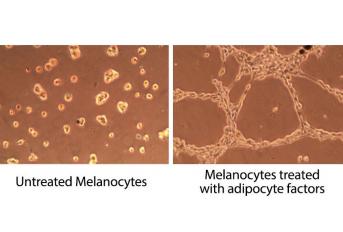Associação Portuguesa de Investigação em Cancro
Effects of Adipocyte Secretome in Melanoma Progression
Effects of Adipocyte Secretome in Melanoma Progression

Effect of Adipocyte Secretome in Melanoma Progression Obesity is a risk factor for several types of malignancies, leading to worsened prognosis, poorer treatment outcome and an increase in cancer-related deaths. There is a positive association between increased body fat and melanoma development and progression, however the implicated mechanisms remain unclear. In this study, recently published in the Journal of Cellular Biochemistry, we used in vitro adipocytes and malignant melanocytes cell cultures to disclosed some of the deleterious effects that adipocyte-released factors exert directly on melanocytes aggressiveness and tumorigenicity. The molecules secreted by the adipocytes increased melanoma proliferation, enhanced cell migration and adhesion capacity as well as simultaneously decreased melanocytes apoptosis and differentiation. Individual differences were also observed between adipocytes from visceral and subcutaneous fat tissues. Additionally, we also unveiled a novel link between obesity and melanoma progression – the induction of tumoural vasculogenic mimicry. The development of these tumour-cell-lined channels by the tumour itself provides an alternative blood supply required for both growth and metastasis. The presence of these “fake” blood vessels stands a predictor of poor prognosis in human melanoma patients and might circumvent the effectiveness of anti-angiogenic therapies.
Pedro Coelho1,2,3, Joana Almeida2,3, Cristina Prudêncio2,3, Rúben Fernandes2,3, Raquel Soares1,3
1- Departamento de Bioquímica, Faculdade de Medicina, Universidade do Porto, Portugal
2- Ciências Químicas e das Biomoléculas, Escola Superior de Tecnologia da Saúde do Porto, Instituto Politécnico do Porto, Portugal
3- Instituto de Inovação e Investigação em Saúde, Universidade do Porto, Portugal
Obesity, favoured by the modern lifestyle, acquired epidemic proportions nowadays. Obesity has been associated with various major causes of death and morbidity including malignant neoplasms. This increased prevalence has been accompanied by a worldwide increase in cutaneous melanoma incidence rates during the last decades. Obesity involvement in melanoma aetiology has been recognized, but the implicated mechanisms remain unclear. In the present study, we address this relationship and investigate the influence of adipocytes secretome on B16-F10 and MeWo melanoma cell lines. Using the 3T3-L1 adipocyte cell line, as well as ex vivo subcutaneous (SAT) and visceral (VAT) adipose tissue conditioned medium, we were able to show that adipocyte-released factors play a dual role in increasing melanoma cell overall survival, both by enhancing proliferation and decreasing apoptosis. B16-F10 cell migration and cell-cell and cell-matrix adhesion capacity were predominantly enhanced in the presence of SAT and VAT released factors. Melanocytes morphology and melanin content were also altered by exposure to adipocyte conditioned medium disclosing a more dedifferentiated phenotype of melanocytes. In addition, exposure to adipocyte-secreted molecules induced melanocytes to rearrange, on 3D cultures, into vessel-like structures and generate characteristic vasculogenic mimicry patterns. These findings are corroborated by the released factors profile of 3T3-L1, SAT and VAT assessed by microarrays, and led us to highlight the mechanisms by which adipose secretome from sub-cutaneous or visceral depots promote melanoma progression.
Journal of Cellular Biochemistry
http://onlinelibrary.wiley.com/doi/10.1002/jcb.25463/abstract




